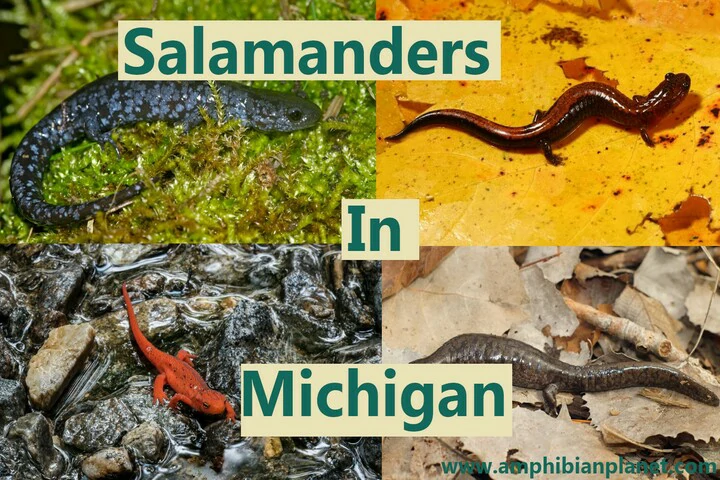The state of Michigan is home to at least 13 different species of salamanders – with some of the most common being the red-backed salamander, and the blue-spotted salamander.
Most of Michigan’s salamanders are terrestrial, which means they live on land. But there are also a few fully aquatic salamander species.
Most terrestrial salamander species typically inhabit shady, forested areas, not far from a water source – and often hide in moist locations such as under rocks, logs, and other debris.
You are most likely to encounter one of these salamanders in the spring because that is when they are most active.
Since there are so many different salamander species, the exact size and coloration varies between species.
Native Salamanders of Michigan
As earlier mentioned, Michigan is home to at least 13 salamander species, some species more common than others.
If you ever spot a salamander in the state of Michigan, It’s probably one of these. You can potentially see salamanders of any age or gender!
1. Blue-Spotted Salamander (Ambystoma Laterale)

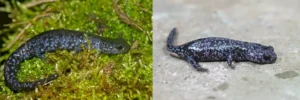
| Average Adult Size (Length) | 3 – 5 inches |
| Average Lifespan (Years) | 10 – 15 |
Blue-spotted salamanders are relatively slender salamanders ranging from 3 to 5 inches in length. They have a long fleshy tail (accounting for about 40% of the total body length) that is broadly oval at the base and compressed towards the tip.
These salamanders have a gray to blue-black coloration with blue spots on their sides, tails, and legs (hence their name).
Blue-spotted salamanders inhabit a wide variety of habitats, which include damp woodlands, deciduous hardwood forests, and even the edges of some open fields.
However, due to habitat loss, these salamanders are threatened in many states. Michigan is one of the only states where blue-spotted salamanders are still very common. They can be found throughout the entire state.
2. Marbled Salamander (Ambystoma Opacum)


| Average Adult Size (Length) | 3 – 5 inches |
| Average Lifespan (Years) | 8 – 10 |
Marbled salamanders are fairly small, only growing 3 to 5 inches in length. They have a dark gray to black coloration with silvery crossbands running along with their chunky bodies. Because of this appearance, they are sometimes called “banded salamanders“.
Male marbled salamanders are typically smaller than females and have whitish crossbands that become very white in the breeding season.
In Michigan, the natural range of these salamanders is poorly documented. It is thought that they occur in the extreme southwestern portion of the state.
However, it is important to note that this species has not been systematically surveyed throughout much of the state.
Marbled salamanders have been documented in Berrien, Van Buren, and Allegan counties – with the last confirmed record in the state being in Allegan County in 1989.
If you see one of these salamanders in the state of Michigan, be sure to quickly report it to the Michigan Herp Atlas.
3. Spotted Salamander (Ambystoma Maculatum)


| Average Adult Size (Length) | 6 – 9 inches |
| Average Lifespan (Years) | 15 – 20 |
Spotted salamanders (sometimes called “yellow-spotted salamanders“) are fairly large, ranging from 6 to 9 inches long, with females typically larger than males.
These salamanders get their name from the two roles of yellow or orange spots speckled along their black backs and sides.
In Michigan, some spotted salamanders have orange spots on the head, while the spots on the body are more yellow in color. The underside is pale gray with no spots.
These salamanders have broad heads and thick, heavy bodies with vertical grooves on each side of their body
Spotted salamanders can be found throughout the entire state of Michigan. However, they are rarely seen outside of the breeding season in early spring.
4. Eastern Tiger Salamander (Ambystoma Tigrinum Tigrinum)
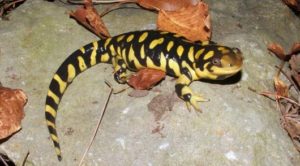
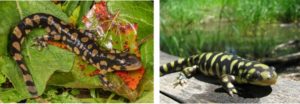
| Average Adult Size (Length) | 6 – 9 inches |
| Average Lifespan (Years) | 15 – 25 |
Eastern tiger salamanders typically range from 6 to 9 inches but can grow up to 13 inches, which makes them the largest terrestrial salamanders in Michigan.
These salamanders can be easily identified by their dull brown coloration, with olive-yellow to brownish-yellow irregular markings (“tiger stripes”). The markings can be large spots, stripes, or irregularly shaped spots.
Some eastern tiger salamanders may have brilliant golden yellow or light brown blotches, while others may be extremely dark with very little noticeable patterning.
In Michigan, eastern tiger salamanders are found in the Upper Peninsula in Marquette, Alger, Delta, Schoolcraft, and Luce counties, and found throughout most of the Lower Peninsula except the uppermost northern region down to the “thumb” area.
However, like the spotted salamander, these salamanders are rarely seen outside of the breeding season – mainly due to their secretive nature.
5. Smallmouth Salamander (Ambystoma Texanum)
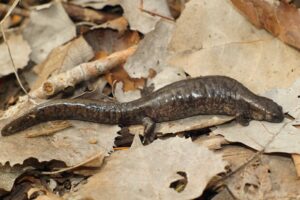
| Average Adult Size (Length) | 4.3 – 7 inches |
| Average Lifespan (Years) | 15 – 20 |
Smallmouth salamanders are sometimes called “Texas salamanders” or “narrow-mouthed salamanders”. They range between 4.3 and 7 inches in length and can be best identified by their small head with a blunt, short snout. The head tends to appear swollen behind the eyes.
These salamanders have a brownish-gray to grayish-black coloration with light gray speckles of lichen-like blotches, particularly along the lower sides of the body. The underside is of the same color with little or no speckling.
Smallmouth salamanders are rarely seen in Michigan. They are only found in the southeastern Lower Peninsula in Hillsdale, Lenawee, Monroe, Wayne, Washtenaw, Jackson, Ingham, Livingston, and Oakland counties.
Smallmouth salamanders are currently listed as an endangered species state of Michigan. If you see one of these salamanders around, be sure to quickly report it to the Michigan Herp Atlas.
6. Northern Dusky Salamander (Desmognathus Fuscu)


| Average Adult Size (Length) | 2 – 5 inches |
| Average Lifespan (Years) | 10 – 15 |
Northern dusky salamanders are fairly small, only growing between 2 to 5 inches in length.
Their coloration is highly variable, but they are generally tan to dark brown with sparse dark spots that are concentrated on the sides, and may also have a light dorsal stripe or two dark dorsal stripes.
Younger individuals may have paired round yellowish spots bordered by a dark wavy band. In older individuals, the spots are gone and the wavy band may be indistinguishable from the body color.
As in all dusky salamander species, a pale line runs diagonally from the eye to the jaw, and the hind legs are noticeably larger than the front legs.
Northern dusky salamanders are very rarely seen in Michigan. In fact, they were not discovered in the state until 2005.
They are mainly found in the Murphy Lake State Game Area in Tuscola County, but there has also been one sighting in Lapeer County.
If you see one of these salamanders in the state of Michigan, remember to report it to the Michigan Herp Atlas.
7. Southern Two-Lined Salamander (Eurycea Cirrigera)
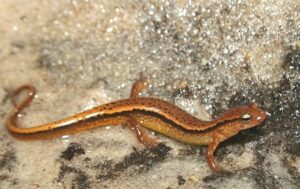

| Average Adult Size (Length) | 2 – 4 inches |
| Average Lifespan (Years) | Unknown, but estimated to be 5 – 10 |
Southern two-lined salamanders are on the small side, only growing between 2 to 3 inches in length. You easily identify them by their greenish-yellow or orange back with two parallel dark brown or black lines running from their eyes to their tail.
Male two-lined salamanders have small projections from the nostrils that point downwards. These projections are thought to help them in chemoreception.
Like the Northern Dusky, Southern two-lined salamanders were only very recently discovered in the state of Michigan.
The first confirmed record in the state is from 2008 – when they discovered in the Murphy Lake State Game Area in Tuscola County. However, in recent years, there have also been sighted in Lapeer County.
When first discovered it was thought that the Two-lined Salamanders which inhabit Michigan are the northern subspecies. However, genetic testing determined that they are the southern subspecies instead.
8. Four-Toed Salamander (Hemidactylium Scutatum)


| Average Adult Size (Length) | 2 – 4 inches |
| Average Lifespan (Years) | Unknown, but estimated to be 8 – 12 |
Four-toed salamanders range from 2 to 4 inches in length. They get their name from the four toes on both their front and hind feet. (Most salamanders have five toes on the back feet, and four on the front feet).
Four-toed salamanders have a reddish-brown or gray-brown coloration on the back, with gray sides and a white belly with black spots.
These salamanders also have an obvious constriction at the base of the tail where it can detach if grabbed by a predator, allowing the salamander to escape.
In Michigan, four-toed salamanders are found throughout the entire state except the “thumb” of the Lower Peninsula.
9. Eastern Red-Backed Salamander (Plethodon Cinereus)

| Average Adult Size (Length) | 2 – 5 inches |
| Average Lifespan (Years) | 15 – 20 |
Red-backed salamanders have slender bodies and reach between 2 and 5 inches. Despite their name, not all “red-backed ” salamanders have the color red on their backs.
They have many color variations but mainly have two variations: The red-back, and the lead- morph.
The red-back morph has a straight-edged reddish stripe (sometimes orange, yellow, or dark gray) running the length of its back from the base of the head to the tail, with dark sides. The lead-back morph, on the other hand, lacks the red stripe. It has a purely dark gray-to-black color on its back instead.
Eastern red-backed salamanders are found throughout the entire state of Michigan – and are by far the state’s most common species of salamander.
The reason these salamanders are so widespread is mainly because they are very hardy and can live in a wide variety of habitats.
10. Eastern Newt (Notophthalmus Viridescens)


| Average Adult Size (Length) | 2 – 5 inches |
| Average Lifespan (Years) | 12 -15 |
Eastern newts grow between 2 and 5 inches in length and are the only newt species found in Michigan. Unlike most salamanders, many newts (including the eastern newt) have rough skin that is slightly moist, (just enough to keep it from drying out).
In the Juvenile eft stage (which lasts about 3 to 4 years), eastern newts have a bright orange-red coloration with a rounded tail.
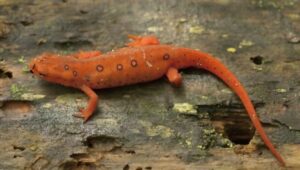
As adults, they generally have a yellowish-brown to greenish-brown coloration, with black-bordered red spots along their back; and a less rounded tail. The underside is yellow with small dark spots.
In Michigan, eastern newts are found throughout the entire state – and are often found not very far from a water source.
Eastern Newts in Michigan Are Actually Two Subspecies
In terms of appearance,
- Red-spotted Newts have two rows of black-bordered red or orange spots on the back, both as efts and adults.
- The Central Newt is smaller, and red spots either lack black borders or are completely absent.
Besides these differences, these two subspecies can be difficult for most people to tell apart.
11. Tremblay’s Salamander (Ambystoma Tremblayi)
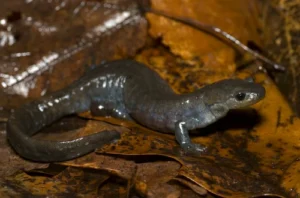
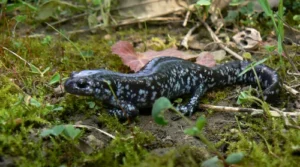
| Average Adult Size (Length) | 3.7 to 6.3 inches |
| Average Lifespan (Years) | Unknown, but estimated to be 10 – 15 |
Tremblay’s salamanders are a hybrid species of Jefferson salamanders (Ambystoma Jeffersonianum) and blue-spotted salamanders (Ambystoma laterale). They show a blending of characteristics of their parental species.
These salamanders typically measure 3.7 to 6.3 inches in length, and have a black or grayish coloration, with blueish spots and flecks on the sides, legs, belly, and tail, and sometimes on the back.
Tremblay’s salamanders are unique in that they are all female complex – which means all Tremblay’s salamanders are female. Due to this, these salamanders reproduce asexually using a breeding strategy called ‘kleptogenesis‘.
To reproduce, the females steal sperm from male blue-spotted salamanders. However, the sperm isn’t to fertilize the eggs, rather, it induces the eggs to develop independently.
The result is that the offspring are exact clones of their mothers without the contribution of genetic material from the sperm. Also, the offspring are all female.
In Michigan, Tremblay’s salamanders are only found in the Southern part of the state.
Aquatic Salamanders in Michigan
Unlike terrestrial salamanders, aquatic salamanders live entirely in the water, even after transforming into adults. This means they have features that are adapted for life in the water, rather than on land.
Aquatic salamanders have more varied features than terrestrial salamanders. Some aquatic salamanders have 4 legs, but others only have forelegs and lack hind legs. Some have gills, but others do not and largely breathe underwater through their skin.
However, despite their varied features, all aquatic salamanders have flat paddle-like tails which they use to swim in their aquatic environments.
There are two aquatic salamander species found in the state of Michigan.
12. Mudpuppy (Necturus Maculosus)


| Average Adult Size (Length) | 7 to 16 inches |
| Average Lifespan (Years) | 15 – 30 |
Mudpuppies reach 7 to 16 inches and are one of the few salamanders that are vocal. They get their name from their squeaky scream which sounds somewhat like a dog’s bark.
Their large size makes them the largest species of salamander – and the largest species of amphibian in the state of Michigan.
Mudpuppies are fully aquatic for their whole lives and retain their larval features even as adults. They have large feathery gills, four feet, and a flat fin that runs down the length of their body.
Their coloration is usually brownish-black with bluish-black spots or blotches. However, younger mudpuppies are often black with yellow stripes running along the length of their bodies.
Mudpuppies can be found in clear creeks, rivers, deep inland lakes, and other cool, oxygen-rich waters throughout the entire state of Michigan.
13. Western Lesser Siren (Siren Intermedia Nettingi)

| Average Adult Size (Length) | 7 to 27 |
| Average Lifespan (Years) | 20 – 30 |
Western lesser sirens typically range from 7 to 27 inches in length. They have a gray to brown to nearly black coloration with a lighter belly. Individuals with lighter coloration often have small dark spots scattered on the head and back.
The name “lesser” comes from the fact that these sirens are typically smaller than greater sirens; lesser sirens are usually less than 2 feet in total length – in contrast, greater sirens frequently exceed 3 feet in total length.
In Michigan, Western lesser sirens are only found in the southwestern Lower Peninsula in Allegan, Barry, Van Buren, Kalamazoo, Cass, and St. Joseph counties.
Conclusion
Michigan is home to at least 13 species of salamander, with some being more common their others.
Most of the salamanders in Michigan are terrestrial – which means they live on land, but there are also 2 fully aquatic species.
These fascinating amphibians are all over Michigan, and you’re sure to catch sight of one if you take the time to look, especially in the springtime when they are most active.

